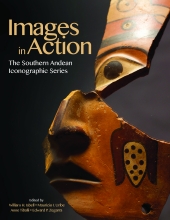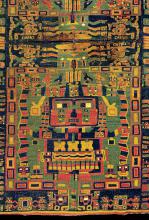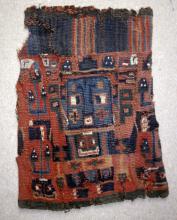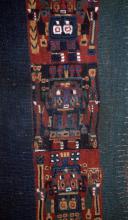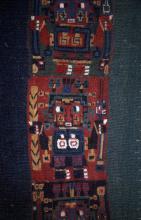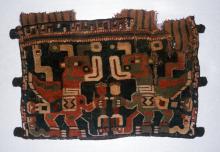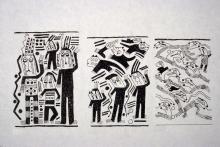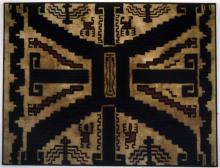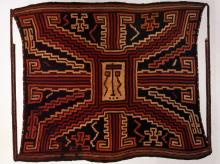Visual database
Provincial Pukara, Gateway Staff Goddess Theme represented on both shoulder panels of the Gateway Tunic (Figure 6.12), dated cal. AD 245 to 402 (SH 257-437).
Provincial Pukara, Rayed Head Theme C represented on a tunic, dated cal. AD 245 to 402 (SH 257-437) See Figure 6.11 for complete image.
Provincial Pukara, "Maize Staff Goddess" holding in each hand a maize plant with cobs that sprouts from a front-face feline head, dated cal. AD 74 to 237 (SH 127-331). Weft and double-strand warp in camelid fibers. The similarity of the design and even the coloring between the bag's upper portion and that of the Siguas 1 bag appearing in Figures 6.38 to 6.39 are surprising. Private collection.
Provincial Pukara, Staff Goddess A with the Staff Goddesses D and B partially visible above and below A, respectively; detail from the "Four Staff Goddesses Mantle," dated cal. AD 218 to 382 (SH 255-414). Weft and single brown warp in camelid fibers. Private collection.
Provincial Pukara, Staff Goddess B with the Staff Goddesses A and C partially visible above and below B, respectively; detail from the "Four Staff Goddesses Mantle," dated cal. AD 218 to 382 (SH 255-414). Weft and single brown warp in camelid fibers. Private collection.
Provincial Pukara, Staff Goddess D with the Staff Goddesses C and A partially visible above and below D, respectively; detail from the "Four Staff Goddesses Mantle," dated cal. AD 218 to 382 (SH 255-414). Weft and single brown warp in camelid fibers. Private collection.
Provincial Pukara, Anthropomorphic Winged Fish B motif represented on a pouch with three tabs on each side with the upper portion of the backflap missing, dated cal. AD 35 to 134 (SH 30-239). The front panel in interlocking tapestry is framed in crosslooping, as are the tabs, weft, and double brown warp in camelid fibers. Private collection.
Siguas 1, roll-out drawings from bands of one engraved cane from a set of nine. The bands are 10.6, 9.8, and 9.1 cm in height, respectively. Note the horn-like appendage on the side of human heads, braided hair, and the two backward-looking animals. Both men and women had braided hair. Private collection. The dates of two engraved canes are available: cal. 206 to 1 BC (Haeberli 2002:Figure 1) and cal. 85 BC to AD 220 (one of the above set of nine, but not the illustrated one).
Siguas 1, Rayed Head Theme A, textile in discontinuous double interlocking warp and weft, both warp and weft in camelid fibers. A textile with similar iconography and a white background color was dated cal. 373 BC to AD 65. Private collection.
Siguas 1, Rayed Head Theme B, textile in discontinuous double interlocking warp and weft, both warp and weft in camelid fibers, dated cal. 206 BC to AD 116. Private collection.
